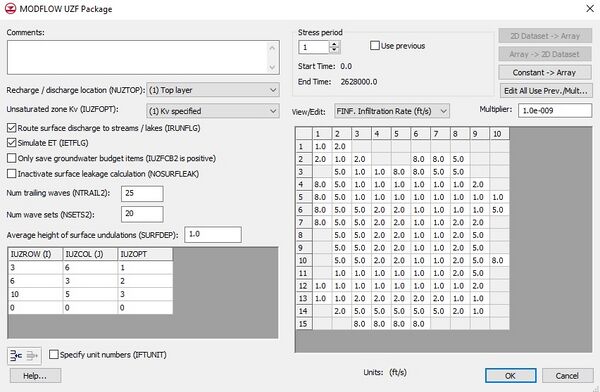GMS:UZF Package
| MODFLOW | |
|---|---|
| Pre-processing | |
| MODFLOW Commands | |
| Building a MODFLOW Model | |
| Map to MODFLOW | |
| Calibration | |
| Packages Supported in GMS | |
| Saving a MODFLOW Simulation | |
| Importing MODFLOW Files | |
| Unsupported MODFLOW Features | |
| Run MODFLOW | |
| Post-processing | |
| MODFLOW Display Options | |
| MODFLOW Post-Processing Viewing Options | |
| Reading a MODFLOW Simulation | |
| Tutorials | |
| Packages | |
| Flow: | BCF6, HUF, LPF, UPW |
| Solvers: | SMS |
| Other: | UZF1 |
The Unsaturated Zone Flow (UZF) package is used to simulate percolation of water through an unsaturated zone. This package is only compatible in GMS with MODFLOW 2005, NWT, and LGR. The UZF Package is available in the UZF Package tutorial.
The inputs to the UZF package are edited in the UZF Package dialog. The inputs to the UZF package are explained here. All of the inputs are labeled using the MODFLOW variable names.
Contents
Stress Periods
The values displayed in the spreadsheet are for an individual stress period for the first 4 arrays (FINF, PET, EXTDP, and EXTWC). The other arrays are not specified per stress period.
Gages
The spreadsheet with the IUZROW, IUZCOL, IFTUNIT, and IUZOPT columns is used to edit gages associated with the UZF package. By default GMS will assign the unit numbers to the gage files (the IFTUNIT variable). However, the user can specify these values by turning on the toggle below the spreadsheet and entering the unit numbers in the IFTUNIT column. Gages can be added or removed by selecting the insert or delete buttons below this spreadsheet.
Care should be taken to enter unique unit numbers. The user can inspect the MODFLOW name file (*.mfn) written by GMS to ensure that the specified unit numbers are unique.
Multiplier
The multiplier is a constant which can be written to the package file with each array. Each value in the array is scaled by the multiplier as the array is imported to MODFLOW.
The values associated with different stress periods can be edited by entering the ID of the desired stress period in the Stress period edit box. If the Use previous option is selected for a given stress period, the values from the previous stress period are used and the spreadsheet is not editable.
Constant → Array
The Constant → Array button brings up a dialog which prompts for a single value. This constant is then assigned to each item in the array for the given stress period.
2D Dataset → Array
The 2D Dataset → Array button brings up the Data Browser listing all of the current datasets associated with the current 2D grid. In order for this button to be active, the 2D grid must have the same number of rows and columns as the 3D grid. The selected dataset is copied to the recharge array. Datasets are typically generated with the 2D Scatter Point module. The 2D Scatter Point module can be used to interpolate from a scattered set of rainfall measurements to the cell locations. If the dataset is transient, the values in the dataset are linearly interpolated, if necessary, to each stress period as the dataset is copied to the array.
Array → 2D Dataset
The Array → 2D Dataset button copies the array to the 2D dataset list associated with the existing 2D grid.
Spreadsheet
The values for the array listed in the View/Edit selection box are shown in the spreadsheet.
| GMS – Groundwater Modeling System | ||
|---|---|---|
| Modules: | 2D Grid • 2D Mesh • 2D Scatter Point • 3D Grid • 3D Mesh • 3D Scatter Point • Boreholes • GIS • Map • Solid • TINs • UGrids | |
| Models: | FEFLOW • FEMWATER • HydroGeoSphere • MODAEM • MODFLOW • MODPATH • mod-PATH3DU • MT3DMS • MT3D-USGS • PEST • PHT3D • RT3D • SEAM3D • SEAWAT • SEEP2D • T-PROGS • ZONEBUDGET | |
| Aquaveo | ||
